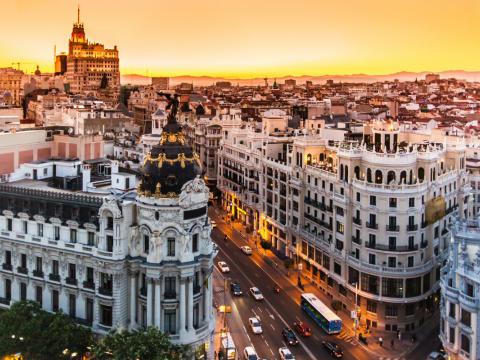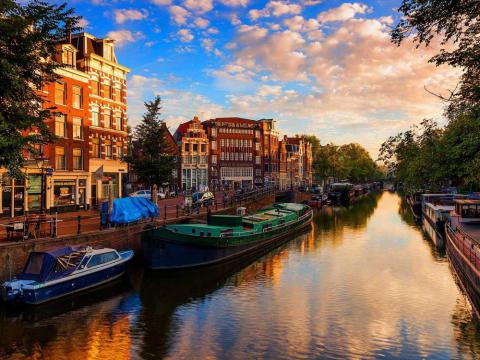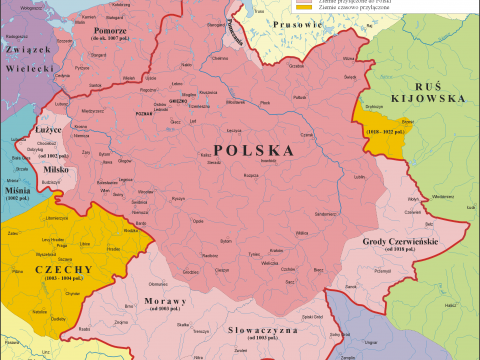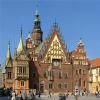Poland in a Nutshell
Poland has a rich, often tragic, history, but has emerged as a great, modern society since the fall of Communism. Highly urbanized, Poland has adopted many Western elements of society, but maintains much of the Eastern culture of its past. Poland spent much of the 1990s developing its economy into one of the strongest of Central Europe.
Location and Geography: Poland is a country in Central Europe, bordered by Germany to the west; the Czech Republic and Slovakia to the south; Ukraine and Belarus to the east; and the Baltic Sea, Kaliningrad Oblast (a Russian exclave) and Lithuania to the north.
Climate: Poland has a temperate climate with hot summers and cold winters. Seasons tend to be more pronounced than in the west and temperatures can get down as low as -20 C in winter and as high as +30 C in summer. The coldest weather tends to hit around February although the last couple of winters have been fairly mild.
Demography: Poland, with 38,544,513 inhabitants, has the eighth-largest population in Europe and the sixth-largest in the European Union. It has a population density of 122 inhabitants per square kilometer (328 per square mile).
The People: Over thousand year history Poland was raid by different nations: Swedish, Turkish, Germans, Russians etc. There is no "typical Polish look", however, one can sometimes tell someone's nationality by their mannerisms and vibes. In Poland they tend to be more conservative and timid in their fashion and character personalities.
History: Slavic peoples settled in today’s Poland in the Early Middle Ages. By the mid-tenth century, kingship dynasties were established. The earliest dynasty, Piast, established Poland as a Christian culture. In 1569, the Union of Lublin formed the Polish-Lithuanian Commonwealth, establishing an early form of democracy. This was in sharp contrast to the rest of Europe in that period. Kings were popularly elected. In 1772, Poland was partitioned into areas controlled by Prussia, Russia, and Austria. The January Uprising of 1863-1864 fought against Russian influence. The uprising failed but led to the birth of Polish nationalism. Polish gained a degree of independence in World War I, and then became embroiled in conflicts with the Soviet Union until Hitler invaded in 1939, sparking World War II. Hitler killed millions of Polish Jews, but the Polish people maintained a strong resistance movement. Following World War II, Poland adopted a communist government under the auspices of the Soviet Union. Their first free election was in 1991, and they joined NATO in 1999.
Religion and Holidays: Polish culture is very religious. The majority of the Polish population follows some form of Christianity, mostly Catholicism. Eastern Orthodoxy and Protestantism have a much smaller presence. Certain elements of ancient Slavic religions are also retained. For instance, on the first day of spring, the Polish set fire to and then drown an effigy of the Slavic goddess Marzanna. Marzanna symbolizes death and winter, so burning her effigy is a way to welcome new life in the spring.
Economy: Despite being a member of the European Union, Poland uses the zloty as currency instead of the Euro. They will eventually become part of the Eurozone, but no target date has been set. Poland’s GDP ranks in the top 25 nation. However, the GDP per capita is significantly lower. Over half of the GDP comes from service industries, followed by industry, with less than 5% of total GDP coming from agriculture.
Money and costs: The Polish currency is the złoty, abbreviated to zł and pronounced zwo-ti. It is divided into 100 groszy, which are abbreviated to gr. Banknotes come in denominations of 10zł, 20zł, 50zł, 100zł and 200zł, and coins in 1gr, 2gr, 5gr, 10gr, 20gr and 50gr, and 1zł, 2zł and 5zł. It’s a stable currency that has held its own with respect to the euro and US dollar in recent years.
Tipping is customary in restaurants and at service establishments, such as hairdressers, but is optional everywhere else. At smaller restaurant establishments and for smaller tabs, round the bill to the nearest 5zł or 10zł increment. Otherwise, 10% is standard. There is no need to tip in taxis, though you may want to round up the fare to reward good service.
Food: Like all cultures, Polish culture has specific important foods. Much of Polish cuisine revolves around the potato, meat, and bread. Pork is a favorite meat in Poland. The Polish people love sandwiches, especially kanapka--open-faced sandwiches. Because of the climate, vegetables are mostly cold weather crops, such as legumes, cabbage, and root vegetables. Spices are typical to Eastern European cuisine.
Poles eat a substantial breakfast and a light supper. In typical European fashion, the most important meal of the day is the midday meal. A normal midday meal consists of a soup course, a main course, and a dessert. Family meals are important, and guests are warmly included.
Cultural Beliefs: There is a cultural concept in Poland called “Polish Hell”. If someone in Poland achieves something, people believe it is either because they stole something or they used other people, rather than working hard—or they simply had connections. “Polish Hell” is an excuse to blame everyone for everything. It doesn’t matter if you achieve success in Poland, because many Poles come up with an excuse for the achievement that diminished it. However, if you fail, you are still subject to tough criticism and blamed for your failures. Communism imprinted the mentality of “worse is better” and “don’t try to get above average.” It is the frustration of the masses in Poland that reveals itself when somebody achieves success; it’s generally assumed someone successful must be a bad person, because he couldn’t have achieved it without some illegal activity.
Health Care: In cases of illness, people use both modern and folk medicine and seek help from practitioners of both. Reliance on folk medicine has been lessening, and modern medicine with physicians, nurses, clinics, pharmacies, and sanatoria is the norm. A recent development is the addition of the speciality of family physician.
Transport: Polish road infrastructure is extensive but local routes may be poorly maintained, and high speed motorways currently in place are insufficient. However, public transport is quite plentiful and inexpensive: buses and trams in cities, and charter buses and trains for long distance travel.
Architecture: Most of the major cities boast lovely old centres and a range of splendid buildings, some of them World Heritage sites. Many old quarters were heavily damaged or even destroyed in WWII bombings, but were meticulously rebuilt after the war, using the original bricks and ornaments where possible. Although remains of the Soviet Union and even scars of the Second World War are visible in most of them, the Polish cities offer great historic sight-seeing while at the same time they have become modern, lively places.
Arts: Polish culture has a strong tradition of oral and folk tales that date back centuries. By the sixteenth century, a strong literary tradition emerged with Mikolay Rej and poet Jan Kochanowski. The early 1800s saw a shift toward Romanticism, as writers such as Adam Mickiewicz began to deal with both Polish political issues and spirituality. Performance arts, especially film, are important aspects of Polish culture, as well. Poland’s cultural scene is active, with hundreds of arts festivals throughout the year.
Government: The highest law is the Constitution of 16 October 1997. The Polish government is divided into three branches: executive, legislative, and judicial. The executive branch includes a president, a prime minister, two deputy prime ministers, and a cabinet or council of ministers. The president, who is the chief of state, is elected by a popular vote for a five-year term. The prime minister and the deputy prime ministers are appointed by the president and confirmed by the Sejm . The prime minister nominates and the president appoints the members of the council of ministers who are then approved by the Sejm.
The legislative branch consists of two houses: the one hundred seat Senate whose members are elected for four-year terms by a majority vote from the provinces, and the four hundred sixty-seat Sejm whose members serve four years and are elected to ensure proportional representation. Four seats are constitutionally reserved for ethnic German parties.
Facts & Figures
Poland is in the Central European (CET) time zone (GMT+1hr). When it’s 12:00 in Poznań it’s 6:00 am in New York City, 11:00 in London, 12:00 in Paris and Berlin and 19:00 in Tokyo. Polish summer time (GMT+2hrs) starts and ends on the last Sundays of March and October.
Przystanek Woodstock is the biggest open-air festival in Europe–an annual free rock music festival in Poland, inspired by and named for the Woodstock Festival.
Poles have won a total of 17 Nobel prizes (more than Japan, China, India or Australia), including four Peace Prizes, and five in Literature.
The river Vistula (Wisła) is Poland's longest river at 1,047km and flows through Krakow and Warsaw before reaching the Bay of Gdańsk (Zatoka Gdańska). Poznań sits on the Warta river which reaches the Baltic via the Odra at Szczecin.
The highest peak is Rysy (2,499m) in the Tatra Mountains on Poland's southern border.
Emergency
In case of an emergency those dialling from a land line or public phone should use the following numbers: 999 for an ambulance, 998 for the fire brigade and 997 for the police. Mobile phone users should call 112 to be forwarded to the relevant department. English speaking assistance is not necessarily guaranteed, and rests on the linguistic capabilities of the operator.
English, German and Russian speakers have the option of using separate lines specifically designed for foreigners in distress: dial +48 608 599 999 or + 48 22 278 77 77. Both numbers can be reached from a mobile phone or a land line and are hotlines in case you run into any troubles during your stay. The lines are active year round with later hours during the high-tourist season.
eBook

This page is a work in progress and a first draft that I wanted to get out there. We're looking for some reasoned feedback.
Last modified on 03/26/2018 - 02:23
Currently there are no places in Poland.
Currently there are no trip reports about Poland.




























